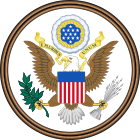The Economy Act of 1932 is an Act of Congress that established the purchasing authority of the federal government. Title VI of this earlier act authorized heads of executive departments, establishments, bureaus, and offices to place orders with any other such Federal agency unless the requisitioned goods or services could be acquired as conveniently or more cheaply from the private sector.[1] It was signed in the final days of the Herbert Hoover administration in February 1933.[2]
 | |
| Effective | June 30, 1932 |
|---|---|
| Citations | |
| Public law | Pub. L. 72–212 |
| Statutes at Large | 47 Stat. 382 |
Section 213
editSection 213 of the Economy Act of 1932 was controversial because it required the government to fire one member of each married couple working in government.[3] The original bill called for the dismissal of wives over husbands, however the text of the bill was changed before finalization due to “fear, on the part of legislators, of the political effect, if discrimination against women were otherwise so clearly and forcibly shown.[4]” The wife's salary was characterized as “pin money” by Frances Perkins, New York's Commissioner of Labor, who said, "“The woman ‘pin-money worker’ who competes with the necessity worker is a menace to society, a selfish, shortsighted creature, who ought to be ashamed of herself...Until we have every woman in this community earning a living wage...I am not willing to encourage those who are under no economic necessities to compete with their charm and education, their superior advantages, against the working girl who has only her two hands.” [3]
The National Woman's Party engaged in a campaign to repeal the law.[5] Section 213 was repealed on July 26, 1937.[6]
References
edit- ^ Steven N. Tomanelli (2003). Appropriations law : principles and practice. Vienna, Va.: Management Concepts. ISBN 1567261213. OCLC 51020333.
- ^ Lee, Mordecai, 1948- (2006). Institutionalizing Congress and the presidency : the U.S. Bureau of Efficiency, 1916-1933 (1st ed.). College Station: Texas A & M University Press. ISBN 9781603445351. OCLC 715188915.
{{cite book}}: CS1 maint: multiple names: authors list (link) CS1 maint: numeric names: authors list (link) - ^ a b Blakemore, Erin. "Why Many Married Women Were Banned From Working During the Great Depression". HISTORY. Retrieved 2019-10-08.
- ^ Dismore, David (September 25, 2013). "Founding Feminists: September 25, 1932". Feminist Majority Foundation. Archived from the original on 2013-09-29. Retrieved October 9, 2019.
- ^ McGuire, John Thomas (2008-10-24). ""The Most Unjust Piece of Legislation": Section 213 of the Economy Act of 1932 and Feminism During the New Deal". Journal of Policy History. 20 (4): 516–541. doi:10.1353/jph.0.0026. ISSN 1528-4190. S2CID 154337203.
- ^ "1930 to 1997 | Historical Timeline of the National Womans Party | Articles and Essays | Women of Protest: Photographs from the Records of the National Woman's Party | Digital Collections | Library of Congress". Library of Congress. Retrieved 2019-10-08.
External links
edit- Economy Act, law.cornell